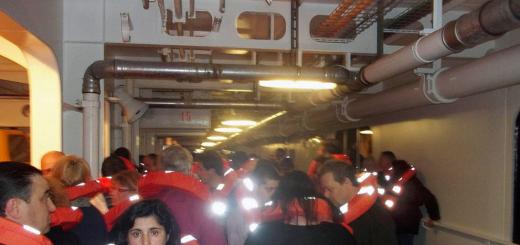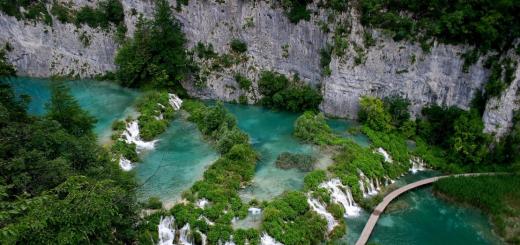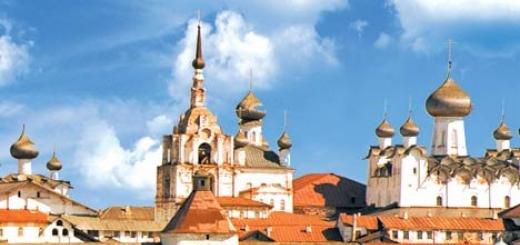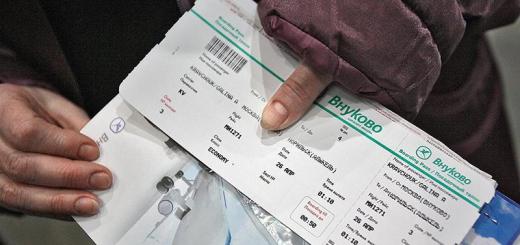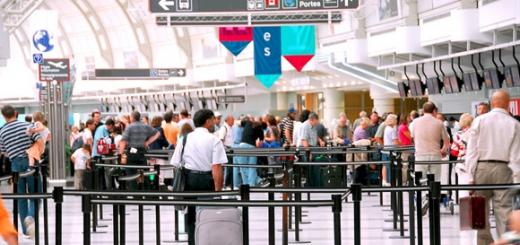The sacred valley of the Inca in Andes - the Valley of the Urubamba River is the place of origin of Incan civilization. Due to the successful location, this valley was fruitful and good climat Even at times, when other regions of modern Peru suffered from many years of drought. The researchers believe that it is the ease with which the valley provided its population with food, allowed the Inca tribe in the XI century to free part of people from agriculture, start conquering nearby territories and create the Great Empire Tauantisuyu (in the language of Kechua Tawantin Suyu, Taantinsuyu, TauantinSuyu, TavantinSuyu, means "Four sides of the world connected together").
Sights of the Sacred Valley
Pisak (Pisac, Pisaq)
Archaeological complex of the city of Sisak is one of the most important in the valley. It is located 33 kilometers from Cusco on the Vilkabamba Ridge. According to the architectural tradition of the Inca of the city was built in the form of a sacred animal or bird - the outlines of the Wisac remind a partrope. Sisak consists of two parts: the actual city and temple and agricultural terraces. This city is also known for its astronomical observatory. In the rock next to the city of Inca, His dead were buried - the mummies sitting in the bud of the embryo were found here (in such a pose of the dead were placed for birth in another life).

In addition to the part of the city, preserved from the Incas and located high on the mountain, there is a colonial part of the Wisac. This is a city built by Spaniards in the Vilcano River Valley (which is known as Urubamba in the lower current). It was built as a reservation, where the conquerors set aside Indians so that it was more convenient to control them and turn them into Christianity.

Ollantaytambo (Ollantaytambo)
This city is located 90 kilometers from Cusco. Inca Pachaktek won this settlement, destroyed the old buildings and built new homes and the ceremonial center. The city is on the way to the jungle and hence the leader of the Incan resistance of Manco Inca Supanza retreat with his treasures and mummies of the ancestors in the legendary city of Vilkabamba (which was not found).
Oljantitambo is significant that this is one of the very few cities of the Inca times, in which residents still live. Part of the buildings B. modern city dated to the end of the 15th century. The planning of the city and the organization of life is also interesting: the main part of the city had a trapezoidal layout with four longitudinal streets, which crossed seven shorter parallel streets.

All buildings in the southern half of the city were something like a hostel: four one-bedroom "apartments", connected by a common patio ( inland yard). Here lived for several families. The city still has a water supply system, built under Pachaktech.
Near the city there are terraces for agriculture, and the granaries are located on the slopes of the mountains, which can be seen now. They were built at high altitude, where, due to the strong wind and lower temperatures, the products and grain were better preserved and were protected from rotting.

Chinchero (Chincchero)
In this city, at the time of the Incan Empire, the royal residence of Tupac Inci Supanza was located. Now Chinchero is interested in visiting to look at the most interesting colonial temple, built right above the walls of the Inka Temple of the Sun. This Catholic Temple is an amazing symbiosis of Spanish colonial and Incan culture. Inside, it is all covered with painting on classic Christian stories, in which, among themes, the culture and religion of the Inca were reflected. Outside the temple on a stepped pedestal, symbolizing Pachamma (Mother-Earth), stands the Christian cross with Incan symbolism. On Square near the temple there is a market with a large selection of handmade goods.


Maras (Maras)
The terraced basins of the Maras Salt Park served and serve for salt mining. Water contains here a large number of Minerals and during evaporation highlights salt. The pools filled with water are left so that the water evaporates, and then they are filled again by repeatedly to obtain a sufficient amount of salt.
Morai (Moray)
This is a surprisingly beautiful complex of terraces for agriculture, built in the form of expanding rings, similar to the amphitheater. The complex is located at an altitude of 3500 meters above sea level.
Each level of the terraces has its own microclimate: the temperature is different, the wind force. The difference between the two neighboring levels of the terraces is approximately equal to 1000 meters under normal farming conditions. Here you can meet up to 20 different types of microclimate. It is believed that during the Incas times, agricultural studies were conducted here: it turned out how different types of plants and cultures behave at different heights. The best seeds and tubers were sent to the regions with the most favorable climate. Thus, the inches managed to increase yields.



Urubamba (Urubamba)
On the outskirts of the city of Urubamba there was a country residence of the Supreme Inka Waire Capac. Here a special microclimate is warm and solar, very different from Cusco microclimate. For the construction of the residence of the Cispiguian and clearing the place for corn, cotton, peanuts and peppers of Chile workers had to move the riverbed of the Urubamba river to the southern part of the valley, dry the swamps and to compose from the hills. The size of the residence is so huge that even when Wain Capac and his guests wanted to hunt, they did not need to leave the territory!

Machu Pickchu (Machu Picchu)
Machu Picchu (in the language of Kechua Machu Pikchu means "Old Mountain") - the mysterious city of Inca, built in the middle of the XV century. It is located about 100 km from the capital of the Inca Empire of the city of Cusco and is so secluded in the Andes that Spanish colonialists could not get to him. We have become known about this city in 1911 thanks to the American scientist from Yiel Hayre Bingham. Although justice it should be noted that local residents Always knew about Machu Picchu, but did not hurry to share information with strangers.
Since 1983, Machu Picchu has been a list of UNESCO human heritage monuments, and since 2007, in the list of new miracles of the world.

Sacred Valley Incov is a terrain in, prostrated along the river Urubamba, roughly from and to the city URKOS.And in the south of the valley ends with the capital of the Empire Inca - the city. On the photo panorama below - view of the sacred valley of the Inca from the fortress Pisac. The Urubamba River flows downstairs, and the road went to Cusco.
Due to the successful location of the Earth, the valleys were amazingly fertile, which allowed the Inca to exist quite scenently, and eventually start creating their empire, conquering the surrounding lands.
The Inca Valley includes a mass of sights.

Machu Picchu - the landmark number 1 not only the valleys of the Inca, but in all the Peru, and perhaps the whole South America. Pickchu Machu is on the mountain and it is not visible from below. Inci specially built the city so high so that no enemy could find him. However, over time, residents left the city for not yet clear reasons. The city has been perfectly preserved, and the sights are preserved next to it - Waire Picchu, the Inca Bridge, and others. About "Lost in Heaven City" Read our separate story.

Olitantambo is one of the most preserved inks cities. The city surrounds the fortress, one of the largest in Peru. It is interesting to wander at different levels of ancient buildings. Amazing polygonal masonry and perfectly sharpened huge monoliths - a business card of the fortress. And falling into the city, you feel that I got into antiquity. Most of the houses have been preserved, and the Op streets, as before, the key water runs in the gutters. About Olitantambo detailed information On our separate page.

Pisac - a city on the Urubamba River, and on the mountain over the city there is an extensive archaeological complex of the Fortress of the Pisak. Here you can see all the elements of the vital activity of the ancient Inca: and agricultural terraces in large numbers, and military fortification structures, and residential buildings, and religious shrines. And from the lesions of the fortress, an excellent view of the Valley of the Urubamba River, or the sacred valley of the Inca. About Fortress Writing Read our separate story.

Cusco - the ancient capital of the Empire Inca. Once Cucco founded the Great Manco Kapack. Cusco drowned in luxury, and the temple of the sun cigrich was completely covered with gold. But the coming conquistadors destroyed many temples and were commissioned their foundation. However, the charm of the ancient city has been preserved to this day. Cultures were mixed, and it made it from Cusco a completely unique city, the second on attendance in Peru after Lima. Read about Cusco our separate story.

Morai is an archaeological complex in the valley of the Inca. It is a group terrace, gradually from the level to the level descending are all deeper until one small round island remains. Scientists believe that Moray served for the Inca of the agricultural laboratory. Having planted different varieties of corn, maize and other cultures at different levels, the Inci watched their growth. At different levels there was a different temperature. Thus, by selection, the most successful plants were selected, and their seeds spread throughout the empire.

Maras is the terraces on which salt was mined. The method of mining is quite simple. Salted water flowing from the subsoil of the earth was roasted through the system of numerous chutes in flat areas - pools, where, due to the large surface of the surface, the water was dried, and the salt was crystallized at the bottom. When a sufficient amount of salt was gained, the water was directed to other terraces, and the salt was collected. The same makes it to this day. See our photo gallery.
Trail Incov

Inca Trail (Inca Trail) is customary to call the track to which hiking to Machu Picchu. However, the Inca was built in their time a whole network of such roads, stretching throughout Peru. Since the incines did not invent the wheels, all trails were intended for hiking movement, so there are many steps on the paths. When the Spaniards came, the Incas were amazed for the first time saw horses who were beautifully climbed along the paths, carrying the empire destruction. Read on our website about the tracking on the tropas of the Inca.

The Fortress Saksauican is located on the mountain over Cusco and is a complex of zigzag fortress walls. Once it was a full fortress, last stronghold Fought against the Spaniards of Inca. The huge monoliths are striking from which the fortress walls are made. Read about the fortress in more detail on the Cusco page.

Bunch - Pukara is another fortress, located near Cuzco. The name is translated as "Red Fortress. Along with Saksauaiman, Bunch - Pukar - part of the defensive structures of the ancient capital of Inca Cusco. From the top of the mountain opens good review On the valley. The fortress is located near the water complex Tambunchae.

Tambo paper is a unique structure, located near Cusco, on the way to Pisak. Delighted Tambomania translates from Kechua as a "resort". it water complex With baths, water jets, various aqueducts and channels. Water is poured everywhere to this day. Not far there were specially irrigated gardens of the Supreme Inca.

Kenko - architectural landmark, located next to Saksauaiman, on the way to Pisac. This is a rather strange building of the Inca, presumably temple complex. Group of stones, from small to huge monoliths, all interesting configuration, with different shapes with cutouts and protrusions. In many respects, it does not look like other structures of the sacred valley of the Inca.

Inca Tupak Manco Jupansi had his residence in Chinchero. Here was built the Temple of the Sun and the pedestal of Pachamma. Conquistadors, as in many places, redesigned holy sites under the Catholic Lad. At the site of the Temple of the Sun, the Catholic Temple is now located, and in the place of Pachamma - the Christian Cross. Of course, in facilities - a mixture of Christianity and the beliefs of the Inca than this complex and makes interest. The Chinchero also hosts a large fair. At this time, a large number of handicraft goods are sold here at low prices, therefore it is highly recommended for visiting Tcriis.
Pikyakyat and Rumikolka

In the south-west of Cusco, the ruins of the ancient Inka city of Piikiykt are located, and quite close to them - Rumyolkka, ancient Incan gate. It looks like a customs gate that defended entry into the Empire Inca.
Search for cheap hotels:
Latest news about Peru:
-
14.03.2019

Two extreme-tourists from Cologne stumbled upon impassable jungle to the settlement of the pre-column culture. The value of findings can be judged after the excavation.
No roads nor even the trails in these rainforests in the north of Peru - about 600 kilometers from the capital. The 27-year-old Tom Schinker and the 28-year-old Martin Druzhel (Martin Druschel), together with local conductors, has accounted for, replacing each other, break through the thicket with a machete.
-
18.12.2017
 The analysis of DNA inhabitants of high-mountainous regions has been traveling with their family in the house on wheels. But this is not a comfortable trailer, which we used to see in the Arsenal of Self-Travelers, and a small car, you can even say - tiny!
The analysis of DNA inhabitants of high-mountainous regions has been traveling with their family in the house on wheels. But this is not a comfortable trailer, which we used to see in the Arsenal of Self-Travelers, and a small car, you can even say - tiny!In this old Volkswagen model, there is everything you need for travel and even more: a tank with a water heater is installed on the roof, there is a TV and microwave, a place for reading, coffee table. The family is not sent to the path and without your favorite pets: aquarium fish, as confirmed to the CenterSoft Academy. Aquarium is also built into the interior of the cabin.
The sacred valley of the Inca in Andes - the Valley of the Urubamba River is the place of origin of Incan civilization. Due to the successful location, this valley was fruitful and a good climate even during times when other regions of modern Peru suffered from many years of drought. The researchers believe that it is the ease with which the valley provided its population with food, allowed the Inca tribe in the XI century to free part of people from agriculture, start conquering nearby territories and create the Great Empire Tauantisuyu (in the language of Kechua Tawantin Suyu, Taantinsuyu, TauantinSuyu, TavantinSuyu, means "Four sides of the world connected together").
Sights of the Sacred Valley
Pisak (Pisac, Pisaq)
Archaeological complex of the city of Sisak is one of the most important in the valley. It is located 33 kilometers from Cusco on the Vilkabamba Ridge. According to the architectural tradition of the Inca of the city was built in the form of a sacred animal or bird - the outlines of the Wisac remind a partrope. Sisak consists of two parts: the actual city and temple and agricultural terraces. This city is also known for its astronomical observatory. In the rock next to the city of Inca, His dead were buried - the mummies sitting in the bud of the embryo were found here (in such a pose of the dead were placed for birth in another life).

In addition to the part of the city, preserved from the Incas and located high on the mountain, there is a colonial part of the Wisac. This is a city built by Spaniards in the Vilcano River Valley (which is known as Urubamba in the lower current). It was built as a reservation, where the conquerors set aside Indians so that it was more convenient to control them and turn them into Christianity.

Ollantaytambo (Ollantaytambo)
This city is located 90 kilometers from Cusco. Inca Pachaktek won this settlement, destroyed the old buildings and built new homes and the ceremonial center. The city is on the way to the jungle and hence the leader of the Incan resistance of Manco Inca Supanza retreat with his treasures and mummies of the ancestors in the legendary city of Vilkabamba (which was not found).
Oljantitambo is significant that this is one of the very few cities of the Inca times, in which residents still live. Part of the buildings in the modern city dates back to the end of the 15th century. The planning of the city and the organization of life is also interesting: the main part of the city had a trapezoidal layout with four longitudinal streets, which crossed seven shorter parallel streets.

All buildings in the southern half of the city were something like a hostel: four one-bedroom "apartments", connected by a common patio (inland courtyard). Here lived for several families. The city still has a water supply system, built under Pachaktech.
Near the city there are terraces for agriculture, and the granaries are located on the slopes of the mountains, which can be seen now. They were built at high altitude, where, due to the strong wind and lower temperatures, the products and grain were better preserved and were protected from rotting.

Chinchero (Chincchero)
In this city, at the time of the Incan Empire, the royal residence of Tupac Inci Supanza was located. Now Chinchero is interested in visiting to look at the most interesting colonial temple, built right above the walls of the Inka Temple of the Sun. This Catholic Temple is an amazing symbiosis of Spanish colonial and Incan culture. Inside, it is all covered with painting on classic Christian stories, in which, among themes, the culture and religion of the Inca were reflected. Outside the temple on a stepped pedestal, symbolizing Pachamma (Mother-Earth), stands the Christian cross with Incan symbolism. On Square near the temple there is a market with a large selection of handmade goods.


Maras (Maras)
The terraced basins of the Maras Salt Park served and serve for salt mining. Water contains a large amount of minerals and evaporates the salt during evaporation. The pools filled with water are left so that the water evaporates, and then they are filled again by repeatedly to obtain a sufficient amount of salt.
Morai (Moray)
This is a surprisingly beautiful complex of terraces for agriculture, built in the form of expanding rings, similar to the amphitheater. The complex is located at an altitude of 3500 meters above sea level.
Each level of the terraces has its own microclimate: the temperature is different, the wind force. The difference between the two neighboring levels of the terraces is approximately equal to 1000 meters under normal farming conditions. Here you can meet up to 20 different types of microclimate. It is believed that during the Incas times, agricultural studies were conducted here: it turned out how different types of plants and cultures behave at different heights. The best seeds and tubers were sent to the regions with the most favorable climate. Thus, the inches managed to increase yields.



Urubamba (Urubamba)
On the outskirts of the city of Urubamba there was a country residence of the Supreme Inka Waire Capac. Here a special microclimate is warm and solar, very different from Cusco microclimate. For the construction of the residence of the Cispiguian and clearing the place for corn, cotton, peanuts and peppers of Chile workers had to move the riverbed of the Urubamba river to the southern part of the valley, dry the swamps and to compose from the hills. The size of the residence is so huge that even when Wain Capac and his guests wanted to hunt, they did not need to leave the territory!

Machu Pickchu (Machu Picchu)
Machu Picchu (in the language of Kechua Machu Pikchu means "Old Mountain") - the mysterious city of Inca, built in the middle of the XV century. It is located about 100 km from the capital of the Inca Empire of the city of Cusco and is so secluded in the Andes that Spanish colonialists could not get to him. We have become known about this city in 1911 thanks to the American scientist from Yiel Hayre Bingham. Although it should be noted justice that the locals always knew Pikchu Machu, but did not hurry to share information with strangers.
Since 1983, Machu Picchu has been a list of UNESCO human heritage monuments, and since 2007, in the list of new miracles of the world.

Peru, Urubamba, Peru
To show on the mapbasic information
Urubamba Valley was sacred Moz For Inca. She is famous for a rich history, beautiful nature And weighing attractions. Urubamba extends between Cusco and the legendary city of Machu Picchu. Due to the high level of moisture, the valley boasts fertile land with beautiful flora.
Here you can walk for a long time admiring incredible landscapes: high mountains, green fields, steep rivers and the ancient structures of the Incas will make each picture magnificent.
Main attractions
- The town of Rakchi, where you can see the Temple of Wiracle - a massive structure from ancient stones
- Pisac is the first stop in the sacred valley. Three times a week, the colorful market works in this town. But the ancient ruins of Incans are considered the main attraction of Sisak
- - Chief Agricultural Center Inca, and now it is the most big City In the sacred valley
- The city of Olitantambo is interesting because the locals live in the houses of the Incas Empire, a little rebuilding them. The main attraction of the city is a temple hill made of outstanding and fitted to each other stone blocks.
- Salinas Salinas de Maras terraces built in the Epoch of Incas are still used for salt mining. From the vertices of the mountains to the surface flows salty waterwhich defends in three thousand unusual stone tanks
- Morai, located at an altitude of 3500 meters above sea level, is famous huge complex Round terraces constructed by inconsisals for agricultural experiments. Ancient people Watched on how they behave certain plants at different heights
- Machu Picchu - this ancient city, built high in the mountains, with many inexplicable mysteries, is the main attraction of Peru, taking tourists from all over the world
How to get
- By bus from the bus station Grau. Time on the way about 1.5 hours, the cost of about 4 salts. Buses depart every 15 minutes
- By taxi from Cusco per hour, the cost of 50 salts
Dear friends, team Site again presents to your attention an overview The next game location is World Of Tanks. Today we will disassemble a rather complicated and ambiguous card - Sacred Valley WOT.
General information.

Picture 1. Minikard.
WOT Map The Sacred Valley was introduced into the game in version 0.8.6 and after that he was constantly on a special control of the developers. She suffered several capital changes, was removed for a long time from the game and now, not so long ago, again appeared in the random in the new guise. The card has a standard size of 1000 * 1000 meters, available for battles of 4 - 11 levels in the only mode of random battles - standard battle. This is a winter card and the winter camouflage will be used here.
Relief card one of the most difficult in the game. It is due to the fact that on the sacred valley there is practically no even place: constant heights, holly, rocks, as well as various buildings (both destroyable and not destroyed). In addition, it is worth noting that artillery here is very difficult here, as it is extremely small, and crazy lights can slip into the positions of SAU at the beginning of the battle.
Look at the key components of the Card Sacred Valley:

Picture 2. Legend.
If you carefully look at the map, you will see how many here are the key components here, but I will try to try to clarify you as much as possible. Understand the map in our game is an extremely important and decisive skill of any player.
- Lower base. It is on the rise, relative to the rest of the map, but has several races at once. Around the perimeter is surrounded by several hillims with thick vegetation, where it often find the use of PT-SAU. However, this position is acquired only during the breakthrough of the right flank or center. On the database itself there are a pair of destroyable houses, which, however, are able to cover the tanks on the capture of the base. In addition, on the Sacred Valley, the artilleryrs do not have any other positions and are almost always standing behind the base.
- Gorge or left flank. The WOT Sacred Valley Map has two basic, but very large and extended flank. The gorge is one of them and its main part is the center of the gorge dedicated to the circle. There is a huge number of travel, races and shelters (including from artillery, which is practically not shot here). Relief Gorge is infinitely pulling, low rocks. The advantage here has a top respaun team, but only due to the fact that most of the random players do not understand one simple nuance, which we will talk about below. Basically, this team is defeated here, which will take as much passages as possible, which will allow you to dispel the attention of opponents and to fire from unexpected places. In the gorge can be an application absolutely all classes of technology.
- Center card. Located at a lower level than the rest of the card, at the level with a lowline number 6. It is characterized by a set of holmikov, buildings (for the most part, destroyed) and practically does not provide any successful tactics for the game, as both main flank are separated from Center for various obstacles. It can be used at the end of the battle, as this is the closest way between two respaunas. However, in the center of this part of the map there is a high rock, from which you can play, but not always successfully. However, the presence of at least one tank here will protect your team from a breakthrough of a light tank to your artillery.
- Top base. Located on uneven hilly terrain with a large number of destroyable buildings. Daffle this base is easier than the lower due to finding in direct visibility from the main shelters of the team. Artillery here is also located, as a rule, behind the base, behind the hill that completely hides them.
- Central rock.
From the bottom, closed with stone walls, but has no races and travel anywhere. It does not represent any gameplay value, except for the possibility of hiding from artillery at the foot of a high cliff, in case of extreme need. However, some educational minds found the options for races on it on certain tanks, but you don't need to know about it, and you don't need it.
Further paragraphs 6, 7, 8, 9 - these are different elements on the meaning and we will disassemble them separately, but all of them, in the aggregate, form a single right flank. The second main and no less huge flank on this map consists of several elements and provides many game opportunities. The main part of the right flank is a temple highlighted in a green circle.
- Lowland. The extended part of the right flank, almost from the base to the base. Is the lowest place on the map. In rare cases, through a nizin, you can maintain an attack on the right flank, but is not the main direction.
- Climb. Here is a convenient position for the highlight of passing enemies from both respauna. Firmly tower tanks with excellent vertical vertex angles can successfully fight. From this lift, it is possible to arrive at the bridge (under the number 8), which leads to the main direction - the temple (under the number 9).
- Bridge. No gameplay function is not posted, except for one, very important - through passage between lifting and temple. However, it should be remembered that the bridge is shot and artillery, and any other tanks, which means that the bridge is necessary with particular accuracy.
- Temple. He is the most important part of the right flank and its center, circled in a circle. The second crowd of your team should be concentrated here. The temple is on the elevation, relatively lowlands and go here in a slide. As a rule, fast and maneuverable tanks are fighting here, which are able to call on the hill without losing strength points along the way. In the temple area there are several large buildings, most of which are not destroyed. You can hide behind these buildings from the gaze of all-seeing artilleryrs and shoot with the enemy.
So how to play on the map Sacred Valley WOT? Let's try to figure it out.

Picture 3. Positions and directions.
Unfortunately, there is no single tactic on the map of the Sacred Valley and will have to act with a loan to the allies, but bearing in mind several nuances that will help you win.
As you can see, there are a lot of possible or probable options for the fight on the sacred valley. The map is oversaturated with tricky roads and unexpected places for attack. It greatly complicates the understanding of the card for not experienced players, and therefore I conventionally divide all options for the attack on three parts:
- Red direction.
The most difficult and conflicted direction on the left flank. Here, the incredible set of narrow passages between the rocks and almost all drives can be played. Mainly, the goal of the teams here is the central part, to control which it is still necessary to capture all the drives leading there to avoid hitting the back. The upper respaun team has some conditional advantage: the fact is that they do not have to think where to go, everything is intuitive, but the team of the lower respaun must necessarily control the area marked with an exclamation mark on a yellow background! It is very important. If the lower command does not control this area, then the tanks at the center of the gorge are simply entering the stern and shoot from both sides. Thus, the bottom team needs to turn on the brain a little to create a balance on this flank. In fact, everything is simple, but in Random, the players do not see this and merge the gorge.
The top respaun team moves along the left flank at the points, which are in parallel and reigns of defense. Fast tanks come from directions and go around the gorge from the rear. The Lower Respaun team is sent to the gorge along the shooters, and positions 1 and 2 serve as defense over defense. Mandatory is to control the area with an exclamation mark, as I wrote above.
- Blue direction. A completely optional direction that can be thrown. In any case, from here it is impossible to develop a successful attack. Go here is one or two tanks, pressing under the rock, designated 0 on a blue background. From here it does not open any successful strips, but you can climb enemy lights here. In addition, allied fireflies, podding a good time, can slip here to the positions of artillery.
- Yellow direction. Everything is somewhat easier here than with the gorge. Fast fastening tanks can occupy positions on the rise from which they will enliver and shoot passing opponents. Attention, you should not try to go here more than two tanks, simply do not fit! Pass on the lowlands under the bridge does not make sense, since there are no shelters and you will be like a palm of opponents. The larger part of your group, who came to the right flank, should rise to the temple and fight here. Again, many random players mistakenly believe that the top respaun team here has an advantage that the root is not true. On the right flank, both teams have the same capabilities and the advantage is only due to more tanks or personal skills.
In addition, you can allocate defined standard positions for artillery (brown areas near the base) and PT-saau (Violet areas, from which it is convenient to dofi, but not to support the attack).
In custody.
On this, our review on a very ambiguous and difficult card approached the end and most importantly, which can be allocated - a small blockage on the balance in favor of the upper respauna. There is nothing critical in this, however, it is not nice. We will wait and hope that sooner or later the developers will pay attention to it.

